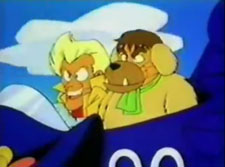Japanese animation really owes it to American cartoons for how they developed their techniques. Many of the early cartoonists there relied on the likes of Disney and Fleischer, which were being released in the country, to use as a frame of reference on how cartoons should look. Even comic books from the ‘States were a big influence (in Japan, comics published in America is referred to as “Amecomi”). From the 1950s and beyond, there were American bases stationed in Japan, and they would often bring comic books with them, which in turn would wind up in these Japanese artists’ hands from one way or another.
So it’s no surprise that American references would wind up in Japanese cartoons, some more overt than the others. I thought I would highlight some of those:
Cyborg 009 (1966)
Based on Shotaro Ishinomori’s manga, Toei turned Cyborg 009 into a feature in 1966. This was notable in that it was their first try at making a feature film with limited animation akin to TV anime. With fuller animation becoming expensive and unsustainable, Toei decided to experiment with lower budget features with this film. It turned out to be a hit, so they gradually started producing their features with limited animation, as well as using this as a jumping point to produce the TV series in 1968.
There was a scene where 007, 006, and 009 sneak into the Black Ghost’s ship. In order to sneak around undetected, 007 transforms himself as a mouse, only to be chased around by a cat inside. The cat and mouse resembles Tom and Jerry, which was airing in Japan at the time, proving to be huge hit with the audience.

Sally the Witch (1966)
Sally is a princess of a magic kingdom who decides to move to Earth to be around humans. Being a witch, she uses her magic to get out of trouble (while also causing them). It was created by Mitsuteru Yokoyama, who in the ‘States is known for also creating “Gigantor” and “Johnny Sokko and His Flying Robot”.
The opening title features Sally tormenting a mouse, changing her hair brush into a cat, leading to a chase that was inspired by Tom and Jerry.
Kaibutsu Kun: Episode 18 (Original Airdate: August 18, 1968)
Sometimes these references are subtle. This episode starts with Prince Kaibutsu accidentally breaking a girl’s doll, which fell from the second floor in the apartment. He promised her that he would get it fixed, going to a toy shop nearby.
As it turns out, the toy shop was run by a man who turns out to be part of the Demon group in Hell. On his side is a puppet, who looks suspiciously like MAD Magazine’s mascot, Alfred E. Neuman. What’s more, in the end of the episode, it’s revealed that he’s the villain, and the man they were fighting was revealed to be a puppet that Neuman was controlling. Such a twist for an anime.
MAD Magazine was surprisingly influential to Japanese cartoonists of the era. Monkey Punch and Fujio Akatsuka has both cited MAD as their influence, and during his appearance on Stu’s Show, Sergio Aragones recounted how he met a lot of these guys when he and the MAD crew went on a trip to Japan, implying that they were already familiar with the publication. It’s only fitting that they would use the magazine’s mascot as the bad guy, even if an average Japanese viewer did not catch the reference.

Mobile Suit SD Gundam (1990)
 “SD Gundam” (SD stands for “Super Deformed”) was part of the Gundam franchise that was more of a parody of the property, similar to how A Pup Named Scooby Doo poked fun at the Scooby Doo franchise. A series of shorts, released both directly to video and theatrically, were made.
“SD Gundam” (SD stands for “Super Deformed”) was part of the Gundam franchise that was more of a parody of the property, similar to how A Pup Named Scooby Doo poked fun at the Scooby Doo franchise. A series of shorts, released both directly to video and theatrically, were made.
One of the shorts poked fun at Hanna-Barbera’s Wacky Races, which was a hugely popular show in the country. One of the racers even resemble Dick Dastardly and Muttley.
Despite being a parody, this segment ran into copyright problems, so when the series was being re-released on DVD, this short was omitted. A copy is online, however, which you can see below.


 Charles Brubaker is a cartoonist originally from Japan. In addition to his work for MAD Magazine and SpongeBob Comics, he also created Ask a Cat for GoComics. You can also follow him on his Tumblr page.
Charles Brubaker is a cartoonist originally from Japan. In addition to his work for MAD Magazine and SpongeBob Comics, he also created Ask a Cat for GoComics. You can also follow him on his Tumblr page.











































Are there going to be further articles on this subject? How about the American cartoon references in Hayao MIyazaki’s movies like ‘Kiki’s Delivery Service’ and ‘Porco Rosso’?
There are also Preston Blair swipes used in an ep of Speed Racer I discovered several years ago.
http://www.cartoonbrew.com/cartoon-culture/preston-blair-swipes-harvey-comics-and-speed-racer-4622.html
Don’t forget about the “Tiny Toons” reference in Lupin III
In the “Lupin III”, 2nd TV series, episode #90, “Bad Guys Are Truly Big Villains” (July 2, 1979), Lupin is in NYC and crashes a rich villain’s fancy-dress ball dressed as Superman. The criminal guests are dressed as an overweight Batman, an ugly Wonder Woman, and so on. The repeating villains who try to kill Lupin are costumed as Spider-Man, Batman, Mickey Mouse, and Zorro.
There is one anime – I’m not sure which – where the main characters are aided in their journey by spirits, I think, who are outright parodies of Ren and Stimpy.
The creator was apparently a big fan.
That was Shaman King…
http://shamanking.wikia.com/wiki/Ponchi_and_Conchi
A much more overt Ren & Stimpy parody can be found in episode 8 of “Panty & Stocking w/Garterbelt”: http://www.ttdila.com/2011/11/cartoon-hype-ren-stimpy-today.html
Ah, yes… that was it.
I wonder how well Ren and Stimpy was received in Japan. Did they enjoy the show or, given the kind of stuff you find in Japanese kids’ programs, was it seen as too tame?
I rather liked the early translated anime of the 1960’s, especially those creations of Osamu Tezuka. These sometimes used voice over talent that was apparent in the much laer Famous Studios cartoons, and the Americanized humor added also made it fun, although I don’t think the Japanese animators were amused at the way their stories and characters were reworked. Also, those earlier bits of anime had a sense of American animation of the golden age, like Tezuka’s scorings for “ASTRO BOY” and, especially, “KIMBA”. I know that there were feature films in Japan that used voice over talent in similar ways to “ASTRO BOY” and “KIMBA” or even “SPEED RACER”. You site TOM AND JERRY references, but I wonder how the overall MGM cartoon library was influencial in early anime, similar to such references throughout “KIMBA THE WHITE LION” which I really grew to like upon its official release in this country through Right Stuff.
There was even a cameo appearance of Bluto in the WWII Japanese animated propaganda feature “Momotaro’s Sea Eagles”, as well as the usage and negative portrayal of Mickey Mouse, Donald Duck, Goofy, Felix The Cat, and Popeye in the Vichy-produced “Nimbus Libere”.
A more recent example that I quite enjoy is Squidward’s cameo in Gurren Lagann.
https://pbs.twimg.com/media/B8gC1prCMAAAitc.png
A number of the artists and directors at Studio Trigger are fans of american animated shows, films, and comic books so they like to sprinkle plenty of these sort of references in their projects.
Just to add to the list there was a Southpark reference in FLCL